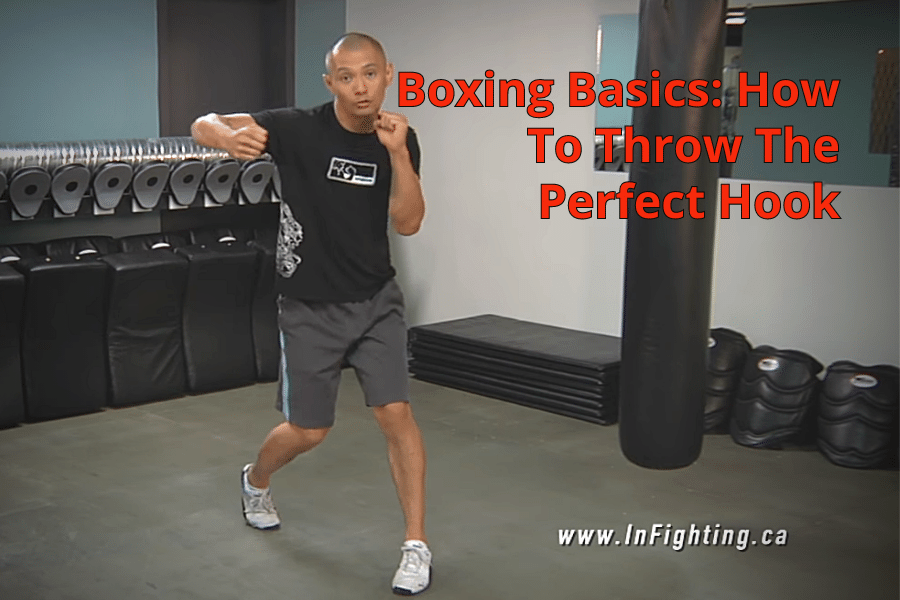
Hey Everybody,
This Boxing basics tutorial is on how to throw the perfect hook in Boxing and Kickboxing. Hooks are power punches with incredible knock out power. We’re going to breakdown every aspect of the hook so you’ll have perfect form and we’re going to talk about how to develop incredible punching power as well.
Let’s start things off with a simple lesson on the form for the right hook. Note how rotating your torso and possessing correct hand position are the key factors behind throwing a proper hook.
Now, let’s look at the left hook. The left hook is arguable the most difficult punch to throw in Boxing. Pay attention once again to the necessary shoulder and hip rotation and the specific hand positioning required for a proper hook.
When most people throw hooks, the don’t rotate their heels; and thus, they do not transfer their weight.
With Boxing basics, you need to understand how heel rotation and weight transfer enhance power development and aid in facilitating hip rotation – a necessary component in power generation for the hook.
The weight transfer is a mere 10% of your weight onto the opposite leg. If you are throwing a left hook, and presuming you are starting with a balanced stance where 50 % of our weight is on your left foot and 50% of your weight is on your right foot, lean 10% of your weight onto your right leg. So then, 40 % of your total weight is on your left foot and 60 % of your total weight is on your right foot.
The weight transfer allows the rotation of your heel; thus, making hip and shoulder rotation possible.
When you cover up for hooks, it’s important to open your hands up and place your palms against your temples. If you make a fist, you will wind up getting your own knuckles pounded into your temples as your opponent hits you.
As well, by opening up your hands, your fingers will make an extension to your shield. Your forearms are your shields when you spar.
When many people launch hooks, they are familiar with covering their head with their other hand in case their training partner launches a counter hook.
But, many people fail to cover up their rib cage as well.
You need to connect your elbow to your hip and your hand to your temple and cover up the entire one side of your body as you launch a hook. You want to cover up the entire side, not just the head, not just the body – people typically only do one or the other.
Hunch your back, slouch, crunch over so your elbow reaches your hip as your hand stays on your head. Give him as few options to counter attack as possible.
Punching power for the hook is directly related to how a nunchuk works.
Why is the nunchuck (a martial arts weapon made famous by Bruce Lee – it basically looks like two little sticks joined together in the middle by a little bit of chain) more devastating than just a normal stick and how does this relate to a left hook in Boxing?
Well, it’s called the conservation of angular momentum. This principle refers to momentum remaining at a constant rate as an object rotates around a pivot point even if the length of the lever, in this case the arm, were to change. To maintain the same degree of angular momentum the velocity increases as the arm shortens.
This is why figure skaters suddenly spin faster as they pull their arms in.
And this is the reason why, if you close your hook up just a little bit at the end by pulling your hand in and flexing your elbow, you will generate far more velocity for your hook with very little additional effort.
The mistake here is that many people do not pull their hand in and rake in at the last moment for their hooks.
When you throw a hook, you want to hug a big tree. This is the perfect degree of bend for your elbows.
That is, the angle of your elbow when you launch a Hook ought to be a bit more than 90 degrees.
A common Boxing basics mistake is that people throw the Hook with the elbow extended too far – this creates a big wide hook that is too easily perceived by your opponent.
As well, you’ll wind up hitting the target with your door knocker knuckles (the knuckles you knock on a door with) instead of the primary knuckles of your fist. This will probably snap your wrists back and could potentially cause a wrist injury.
In addition, many people bend their elbows too much and have their fist too close to their body when they throw Hooks.
Because of the rotational nature of the Hook, if thrown with the hand too close to the body and with too much flexion in the elbow, it will be like choking up too high on the handle of a bat, rather than gripping the bat at the tail end: you won’t generate as much power. The longer the lever, the greater the resultant velocity of the end of the bat. With too much flexion in the elbow – it looks like you are hugging a really narrow, skinny tree – you won’t have as much leverage to generate the subsequent velocity of the punch.
Again, the ideal degree of flexion in your elbow when throwing a hook is about 90 degrees.
With Boxing basics, there’s is rampant confusion over whether to throw the hook with the fist in a thumb up position (if you were to take your fist as you execute the hook and open up your hand the thumb would point to the sky) or the palm down position (if you were to open up your fist at the moment of impact for the hook, your palm would face the floor).
The answer is that the tool should augment to fit the target. The mistake is for someone to throw a hook in a thumb up position always, regardless of the target or body positioning
If you have a clear opening to the jaw line of your opponent, use the palm down position for the fist. You will make contact on his jaw with as many knuckles of your fist as possible.
On most men, the mandible, or lower jaw, sticks out farther than the upper jaw, the maxilla. If you have a thumb up position as you strike his jaw, you may break your pinkie finger knuckle or ring finger knuckle since it will only be one of these knuckles that will make first contact.
By using the palm down position, more of the force will be spread out along your knuckles, typically the last 3 knuckles- the pinkie, ring finger and middle finger knuckles – and you’ll save yourself a broken hand.
Now, if you have an opponent that is all covered up, you can still get inside if you throw your hook past his head and then rake in with a chopping hook behind his forearm nailing him directly on the ear or on the temple.
This works best with a thumb up position. The fist is narrower and can slide in behind the forearm cover. If you have a palm down version of a fist with this attack you’ll probably still get in and be able to hit him, but it will be with the knuckle of your thumb or with the knuckle of your index finger. Punching in this manner will most likely cause you to break your hand.
The conventional way of executing a hook is to have your forearm parallel to the ground.
When you are executing the hook, at the moment of impact the elbow ought to be a the same level as the hand.
A common Boxing basics mistake when throwing a hook is to keep your elbow too low. The elbow should – at least – be at the same height as your hand at the moment of impact.
Remember, most people will be hiding their chin behind their shoulder. To get to the chin with a hook, you’ll have to get up and over the shoulder; so, it may be necessary to pick your elbow up higher than your hand.
As well, you’ll save yourself from injury. If you keep your elbow lower than your hand, you’ll wind up throwing a hammer strike with the base of your hand. Not only could you hurt your wrist, but it will put strain on your shoulder as you are forcing it to turn in an unnatural way.
Finally, you will not have much power with your hook.
Seeing how force is generated by mass and acceleration, with the hammer strike, you are using only the mass of the hand to create the force for you hook.
If you lift the elbow, the mass will be of your hand and your forearm. This is significant because the forearm is made up of 2 big bones, the ulna and the radius.
Lift the elbow up higher than the level of your hand for the hook and your hook will be more powerful, more accurate, and it will save your shoulders.
I hope you found this Boxing basics article on how to throw the perfect hook to be helpful and comprehensive. If you have any questions, please feel free to add a comment below and i’ll do my best to get back to you.
Thanks everyone!


